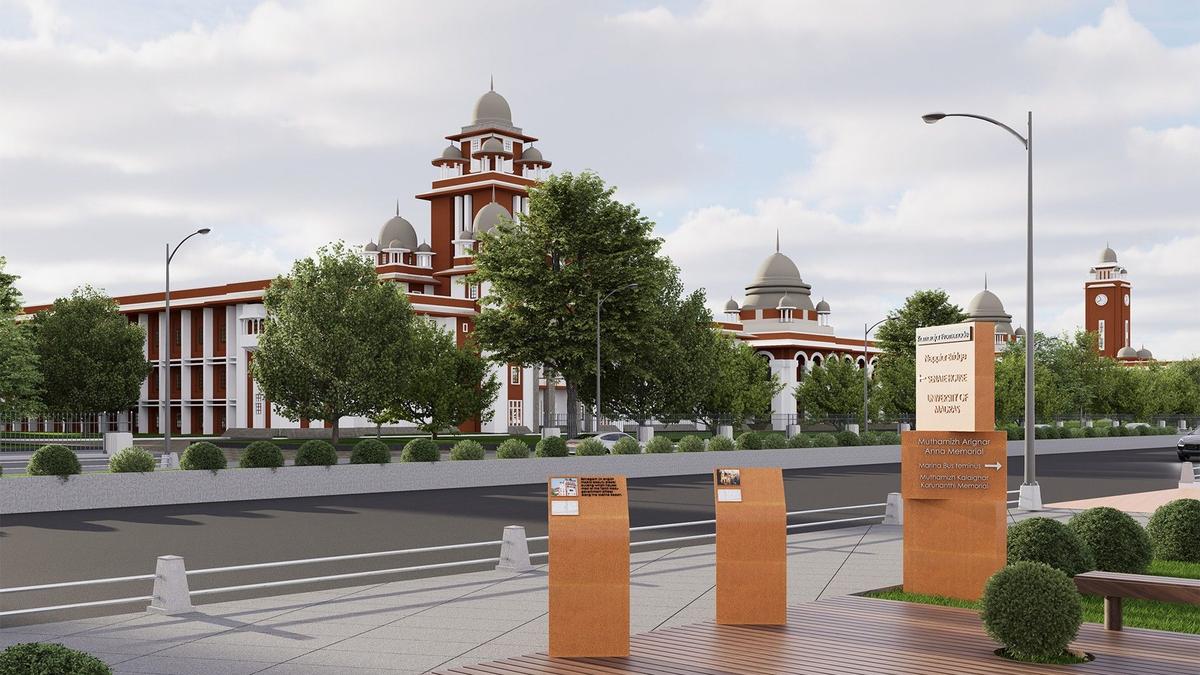Spotlight on the coast: The stretch lies within 500 metres of the sea, but CMDA officials say the Coastal Regulation Zone clearance is not required because the project does not involve permanent structures.
| Photo Credit: Special Arrangement
“From Santhome to Fort St. George runs the Marina, a broad road along the sea-front some two miles in length,” wrote Charles J. Molony, former president of the Madras Corporation. “Here, all Madras pours out of an evening, on foot, on bicycles, in carriages, in motors, to meet the cool evening breeze that blows in from the sea.”
Over a century later, the same stretch is set for a makeover. In 10 months, the Marina Beach will get a ₹18.45-crore transformation, as the Chennai Metropolitan Development Authority (CMDA) has unveiled plans for the Marina Heritage Corridor Development Project.
Spanning 2.5 km from the Lighthouse to the Island Grounds, the project will combine heritage aesthetics with modern amenities to enhance the look and functionality of the city’s coastal promenade.
According to an official of the CMDA, the corridor has been envisioned as a heritage-led urban regeneration project aimed at preserving the historic character of the Marina while responding to the city’s current public infrastructure needs. The project will feature a range of new interventions, including bus stops, viewing decks, police booths, cycle tracks, and public walkways, the official says.
The stretch lies within 500 metres of the sea, but CMDA officials say the Coastal Regulation Zone (CRZ) clearance is not required because the project does not involve permanent structures. It has coordinated with the Greater Chennai Corporation (GCC) to ensure compliance, they add.
Old and new
Nine bus stops will be built along the corridor in the Indo-Saracenic architectural style, unlike the regular bus shelters seen across the city. The structures will use a combination of stone, brick, and terracotta-toned materials.
The officials say the bus stops have been designed with arched openings and lattice brickwork to promote ventilation and visual transparency. They will also have green buffers and shaded benches, besides digital display panels and tactile paving for inclusivity.
Dedicated cycle track
A dedicated cycle track is part of the plan. It will be constructed with a weather-resistant surface and marked lanes to support safe non-motorised transport along the beach. The track will include signage, lighting, and rest points. The track is meant to revive the original character of the promenade, which once supported horse-drawn carriages and leisurely rides along the coast, the officials add.
Police booths will be established at key points along the corridor. The CMDA has said in the report that these booths will be temporary structures made of metal frames and aluminium composite panels. Though compact in design, the booths will feature arched motifs and integrated lighting for visibility and night-time use. They will function as accessible points for public assistance.
Viewing decks
Viewing decks are planned at several heritage points. They include locations near Presidency College, Senate House, Madras University, Oriental Research Institute, the DGP Office (formerly Masonic Lodge), and Ice House. Each deck will be designed to align with key sight-lines that frame the heritage buildings and their surroundings. The decks will include seating, shaded areas, and informational panels describing the history and architecture of the buildings in view.
QR codes will be placed on the panels to link visitors to a self-guided heritage trail. Officials say this element was added to encourage deeper public engagement with Chennai’s historic coastal stretch. The decks will form part of a curated sequence of stops along the Marina, enabling visitors to experience its cultural and architectural evolution, according to the report.
The report also confirms that heritage conservation guidelines specific to the Marina have been adopted for the project to protect and reflect the site’s architectural identity by regulating building heights, circulation patterns, and stylistic features. These guidelines were developed in line with the Justice E. Padmanabhan Committee Report, which identifies the Marina Beach zone as a historically significant area.
Officials say the use of exposed brick, lattice brickwork, and traditional stone finishes will help preserve the visual language of the precinct. All elements of the corridor — such as fixtures, signage, and structural finishes — are to be approved individually to ensure that they comply with the conservation approach adopted, according to the project overview.
Inclusive corridor
The report says the corridor is meant to be inclusive and accessible, with pedestrian comfort and public safety being the core objectives. Lighting across the stretch will be upgraded with heritage-themed fixtures. Rest areas and transition points between cyclist and pedestrian zones will be carefully planned to minimise conflict and enhance usability.
Officials say the aim is to create a promenade that will function as a heritage precinct as well as a public realm for daily use. The interventions are intended to balance legacy preservation with ecological and urban sustainability, even while reflecting the changing needs of the city’s coastal communities.
Published – April 20, 2025 10:03 pm IST
